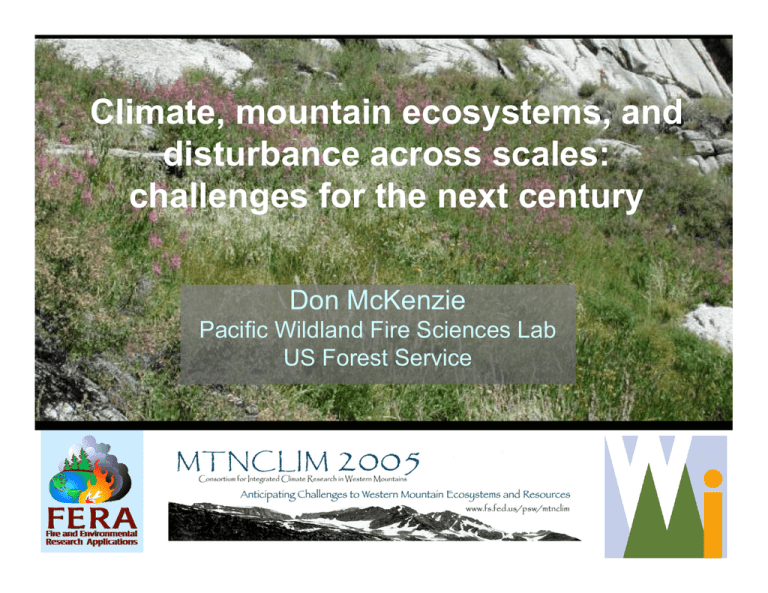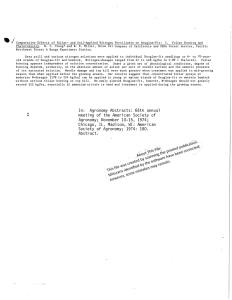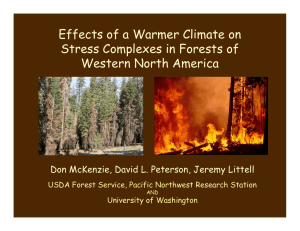Climate, mountain ecosystems, and disturbance across scales: challenges for the next century
advertisement

Climate, mountain ecosystems, and disturbance across scales: challenges for the next century Don McKenzie Pacific Wildland Fire Sciences Lab US Forest Service with assistance and inspiration from • • • • • • • • Craig Allen Sam Cushman Ze’ev Gedalof Paul Hessburg Phil Higuera Lara Kellogg Jeremy Littell Carol Miller • • • • • • • • Max Moritz Bruce Milne Phil Mote Ron Neilson Dave Peterson Steve Running Nate Stephenson Tom Veblen Challenges • Biophysical controls on species distribution and abundance • Fire regimes in context of climatic variability • Linking drivers and responses across scales Species distribution and abundance • Conifer tree species of western mountains • West-east gradients across Cascade Range • Energy and water as canonical limiting factors High Water Energy Low Energy and water limited • • Summer drought Temperature increases possibly associated with increased growth 1.4 PIPO PSME TSME ABLA2 ABGR ABAM 0.8 0.6 0.4 0.2 0.0 Proportion of total 1.0 1.2 Relative abundance of 6 key species along a west-east gradient in Washington State MBS Grizzly Wenatchee Okanogan Colville Br. A. Brousseau – St. Mary’s College C. Webber – California Academy of Sciences Mountain hemlock (Tsuga mertensiana) GLM AUC = 0.907 R2 = 0.396 McKenzie et al. (2003) Peterson & Peterson (2001) Observed: association between environmental factors and species distributions in eastside forests, but not in westside forests. Working hypotheses • Water-limited systems and energylimited ecosystems display different dynamics. • Abiotic controls on species in waterlimited ecosystems; biotic controls in energy-limited ecosystems. CCA - species/environment biplot – Wenatchee NF R2 1 Axis 1 Axis 2 Axis 3 Total TSHE THPL ABAM tdayann soilDD baseflow pptann 0 CHNO Axis 2 aspect TSME 0.106 0.057 0.009 0.172 PSME ABGR LAOC PIPO soilW -1 PIEN PICO sradann ABLA2 -2 PIAL -1.5 -1.0 -0.5 0.0 Axis 1 0.5 1.0 1.5 CCA - species/environment biplot – Mt. Baker/Snoqualmie NF 0.4 0.6 R2 aspect 0.2 baseflow Axis 1 Axis 2 Axis 3 Total 0.174 0.016 0.010 0.200 tdayann 0.0 soilDD ABAM PICO soilW -0.2 pptann ABGR PIEN TSME -0.4 PSME ABLA2 sradann -0.6 Axis 2 THPL TSHE -1.5 -1.0 -0.5 0.0 Axis 1 0.5 1.0 1.5 TSME Multivariate regression (composition) TSME Water-limited (Wenatchee) ABLA2 ABAM ABLA2 ABAM TSME TSME Energy-limited (MBS) ABLA2 ABAM ABLA2 ABAM TSME Generalized linear models (composition) TSME Water-limited (Wenatchee) ABLA2 ABAM ABLA2 TSME ABAM TSME Energy-limited (MBS) Mean R2 = 0.25 ABLA2 ABAM ABLA2 ABAM Wenatchee NF Mt. Baker/Snoqualmie NF AUC (classification accuracy) 0.8 1.0 Relative performance of models Energy-limited? Abiotic Biotic R2 R2 R2 0.0 0.2 0.4 0.6 Water-limited? GLMs CCA GLMs (p/a) (p/a + composition) (composition) Changing relationship over time between precipitation and growth Precipitation coefficient Long-term trend (due to gradual warming) 0 Energy-limited? Decoupling High variability, sensitive to e.g., excessive snowpack Water-limited? Time Very sensitive to e.g., drought Recoupling Challenge #1 Dynamics of energy-limited vs. water-limited systems • Coupling climate, vegetation, and terrain (Milne et al. 2001). • The “ecotone” (if any) of limiting factors vs. biolcimatic envelopes. • Simulation vs. empirical approaches. Fire regimes in the context of climatic variability “The historical dynamics of any real landscape are one realization of a stochastic process… we have access to only the single series of fires that has actually occurred.” Lertzman (1998) Air quality in protected areas Hai Habitat Fire-related issues Exotics (e.g., Bromus tectorum) Closed-canopy & stable microclimate Mixed-severity fire Fire Disturbance synergy Climate Vegetation 25-100 yr Climatic change 100-500 yr Habitat changes Broad-scale homogeneity Truncated succession Loss of forest cover Loss of refugia Fire-adapted species New fire regimes More frequent fire More extreme events Greater area burned Species responses Fire-sensitive species Annuals & weedy species Specialists with restricted ranges • Frequency Mean – Variance – Synchrony – Scale – • Severity – Mean – Variance – Thresholds/extremes Intuitively, there is an inverse relationship • Extent – Mean – Variance – Thresholds? Intuitively, there is a negative feedback as extent reaches a certain proportion of available area. N Fire history sites in eastern Washington SOUTH DEEP 18 km QUARTZITE USFSService Boundary Forest Boundary Recorder Tree Locations 11 km SWAUK SWAUK NILE CREEK 20 km 14 km ENTIAT ENTIAT 16 km WMPI = 6.5 | | | | | | | | | | | Polygons in Entiat watershed | | | | | | | | | | | | | | | | | | | | | | | | | | | || | | | | 1700 | | | | | | | | | | | | | | | | | | | | | | | | | | | | | | | | | | | | | | | | | | | | | | | | | | | | | | | | | | | | | | | | | || | | 1750 | | | | | | | | | | | | | | | | | | | | | | | | | | | | | | | | | | |||| | | | | | | | | | | | | | | | | | | | | S22 S25 S23 R5 R7 R6 R24 R8 T2 S21 B6 T4 T3 S10 R21 R20 D2 B7 S11 S6 D4 B4 R2 S9 R3 B5 D1 S8 D6 T5 R4 S26 | | | | | | | | | | | | | | | | | | | | | | | | | | | | | | | | | | | | | | | | | | | | | | | | | | | | | | | | | | | | | | || | 1800 | | | | 1850 Composite 1900 Year WMPI = 6.0 | | | | | | | | | | | | | | | | | | | | | | | | | | | | | Frequency Synchrony | | | | | | | | | | | | | | | | | ||| 1700 | | | | | | | | | | | | | | | | | | | | | | | | | | | | | | | | | | | | | | | | | | | | | | | | | | | | | | | | | || | | | | | || | 1750 | | | | | | | | | | | | | | | | | | | | | | | | || | 1800 Year | | | | | | | | | | | | | | | | | | | | | | | | | | | | | | | | | | | | | | | | | | | | | | | | | | | | | | | | | | | | | | | | | | | | | | | | | | | | | | | | | | | | | | | | | | | | | | | | | | | | | | | | | | | | | | | | | | | | | | | | | | | | | | | | | | | | | | | | | | | | | | | | | | | | | | | | | | | | | | | ||| | | | | | | | | | | | | | | | | | | | | | | | | | | | | | | | | | | | | | | | | | | | | | | | | | | | | | | | | | | | | | | | | | | | | | | | | | | | | 1850 | | | | | | | | | | || | 1900 | | 4-8 4-6 3A-3 KX3 4-7 4-5 4-15 3B-3 3A-1 2-2 4-17 4-11 3A-2 4-9 3D-2 1-3 4-10 4-2 4-12 4-3 3C-2 3C-1 3B-1 4-14 4-1 1-2 3D-1 2-4 2-3 3B-4 1-1 2-1 4-16 4-13 4-4 Composite yg | WMPI = 28.3 | | | | | Polygons in South Deep watershed | | | | | | | | | | | | | | | | | | | | | | | | | | | | | | | | | | | | | | | | | | | | | | | | | | | | | | | | | 1400 1500 | || 1700 d30 | | | | a24 | a22 | | a40 a27 | | l8 k34 | | | | | | | | a23 a41 a26 | | 1600 | | | | r60 d23 | | k35 | | | | | | a21 | l6 l2 | | || 1800 Composite 1900 ygYear | WMPI = 17.9 | | | | | | | | | | | | | | Frequency Synchrony | | | | 1600 | | | | | | | | | | | | | | | | | | | | | | | | | | | | | | | | | | | | | | | | | | | | r2 r3 | d1 | a11 k2 | | | a1 | | | | | | d2 d11 | r5 | d5 k31 | | d6 | | k30 | | | | | | | | | | | | | | | | | | | | | | | | | || | ||| d4 k1 k29 1700 1800 Year 1900 r15 | || Composite Vegetation transitions with increased mean fire frequency Alder/ash Aspen/birch Spruce/hemlock Cedar/hemlock/pine Hemlock/Douglas-fir Silver fir/Douglas-fir Douglas-fir Ponderosa pine Mixed conifer W. oakwoods Aspen parkland Redwood Pinyon/juniper Pine/cypress Fir/spruce Lodgepole pine Alpine tundra GrBasin pine Short grass prairie GrBasin shrub Chaparral Desert grass Desert shrub McKenzie et al. (1996) Mesquite Mixed grass prairie McKenzie et al. (1996) Pre-transition Aggregated Küchler Vegetation Types Post-transition Desert Great Basin shrub N. Floodplain Shortgrass prairie Desert grassland Hemlock/Douglas-fir Oak/juniper Silver fir/Douglas-fir Alder/ash Desert shrub Lodgepole pine Pine/cypress Spruce/hemlock Alpine tundra Douglas-fir Mesquite savanna Pinyon/juniper Tallgrass prairie Cedar/hemlock/pine Grassland/wetland Mixed conifer Ponderosa pine W. Fir/spruce Chaparral Great Basin pine Mixed grass prairie Redwood W. Oakwoods Projected increases in area burned -- Washington (McKenzie et al. 2004) Projected increases in area burned -- Montana (McKenzie et al. 2004) Climatic change and controls on fire ENSO? Climate Temperature increases Cerro Grande Topography Management AREA BURNED (ha) Fuels 12000 Nahuel Huapi N.P., Patagonia 8000 4000 0 1940 1960 YEAR 1980 2000 Challenge #2 Fire severity as a random variable • Effects on ecosystem of: – Change in the mean (e.g., New Mexico & Cerro Grande) – Change in the variance (Clark 1996) – Change in the extremes • Thresholds representing points of no return – – – – – Forced by climatic change? Alternative stable states or devolution of ecosystems? “No modern analogue” Coincidence of extreme events and climatic change Examples of cheatgrass and buffelgrass Linking drivers and response across scales “___ controls ___ at multiple spatial and temporal scales.” Anonymous (200x) “At middle scales we have a problem…” • “…intractable to extend fine-scale mechanistic relationships between organisms and their environments across space and time…” • “…regional- and continental-scale relationships lose explanatory power due to increasing spatial and temporal variance.” Cushman and Littell (2005) N Fire history sites in eastern Washington SOUTH DEEP 18 km QUARTZITE USFSService Boundary Forest Boundary Recorder Tree Locations 11 km SWAUK SWAUK NILE CREEK 20 km 14 km ENTIAT ENTIAT 16 km Historical fire and climate across eastern Washington (Hessl et al. 2004) 1 12 1684-1900 r = -0.577 P < 0.001 10 0.5 8 0 6 -0.5 4 -1 2 -1.5 1650 1700 1750 1800 1850 Year 1900 1950 0 2000 10-yr Mean Percent Scarred 10-yr Mean Reconstructed PDSI 1684-1978 r = -0.375 P < 0.001 Watershed scale Arrows = ranges of anisotropic variograms SWAUK 14 km 14 km Large cluster groups (~ fire synchrony) cluster in homogeneous areas Kellogg (2004) Swauk Creek 600 800 200 400 600 Search radius (m) Search radius (m) Quartzite South Deep 800 1.28 1.20 1.24 Weibull shape parameter 2.4 2.2 Weibull shape parameter 2.0 1.8 400 600 Search radius (m) 800 400 500 600 700 Search radius (m) 1.70 200 400 600 800 Search radius (m) N.S. 200 1.65 1.55 1.6 400 2.6 200 ? 1.60 1.8 1.9 2.0 Weibull shape parameter 2.1 1.75 2.2 Entiat River 1.7 Weibull shape parameter 2.0 1.9 1.8 1.7 1.6 1.5 Weibull shape parameter 2.1 Nile Creek Changes in the (fire) hazard function associated with different spatial scales of analysis. Vertical lines approximate range of fuel constraint on fire. 800 McKenzie et al. (in review) Complexity across scales in fire regimes Fuel consumption YEARS STAND Fuel (type, amount) Fuel moisture Physics of heat transfer Fire behavior slope effects Shading, live moisture stress Ppt, T, RH, solar rad. Topography Ppt, T, growing season Biomass production CENTURIES Vegetation T, wind Weather Topography ----------Climate Drought, fire season frequency, severity, season, size, variability severity, size Fire regime Mortality, scorch, N mineralization, seedbed prep. REGION Carol Miller (2004) Mountain landscapes and the middle-number problem Scale mismatch between drivers and responses Multiple stochastic elements with no equilibrium Neilson, Lenihan, Bachelet, et al. Stands ? Landscapes ? Continents Linking drivers and responses across scales Challenge #3 • Scaling laws or scale invariance – Disturbance event/area relationships (Falk, Miller, McKenzie, et al. in prep.). – Self-affine properties of drivers, responses, or both. • Transfer functions – Hierarchical modeling? (Cushman and McGarigal 2003) – “Minimum-variance” aggregation (Rastetter et al. 1992) • Examples – Climate anomalies and disturbance regimes (Hessburg et al. 2005). – Linking forcing functions to scaling relations rather than single-scale responses. Thanks! Discussion?





